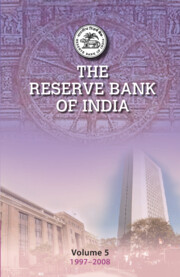Book contents
- Frontmatter
- Contents
- Tables
- Boxes
- Foreword
- Preface
- Acknowledgements
- List of Abbreviations
- 1 Introduction: Managing Liberalisation
- 2 The Macroeconomic Context
- 3 Monetary Management
- 4 Foreign Exchange Market and Management of the Capital Account
- 5 Foreign Exchange Reserves Management
- 6 Financial Markets
- 7 Public Debt Management
- 8 The Payment and Settlement Systems
- 9 Currency Management
- 10 Regulation of the Financial System – Part I: Commercial Banks
- 10 Regulation of the Financial System Part II: Other Financial Institutions
- 11 Supervision of the Financial System
- 12 Rural Credit
- 13 Financial Inclusion
- 14 Communication Policy
- 15 Organisational Change
- Appendices
- Photographs
- Select Bibliography
- Index
Foreword
Published online by Cambridge University Press: 10 January 2023
- Frontmatter
- Contents
- Tables
- Boxes
- Foreword
- Preface
- Acknowledgements
- List of Abbreviations
- 1 Introduction: Managing Liberalisation
- 2 The Macroeconomic Context
- 3 Monetary Management
- 4 Foreign Exchange Market and Management of the Capital Account
- 5 Foreign Exchange Reserves Management
- 6 Financial Markets
- 7 Public Debt Management
- 8 The Payment and Settlement Systems
- 9 Currency Management
- 10 Regulation of the Financial System – Part I: Commercial Banks
- 10 Regulation of the Financial System Part II: Other Financial Institutions
- 11 Supervision of the Financial System
- 12 Rural Credit
- 13 Financial Inclusion
- 14 Communication Policy
- 15 Organisational Change
- Appendices
- Photographs
- Select Bibliography
- Index
Summary
Unravelling the past in an objective and systematic manner brings with it many positive learnings that can shine a light on the path ahead. While grappling with contemporary complex policy dilemmas, a reference to institutional history often provides valuable guidance on time and context specific policy responses and their impact. I am happy to note that the documenting of its history by successive generations is entrenched as a living tradition in the Reserve Bank of India. This volume – The Reserve Bank of India (1997–2008), the fifth in the series – provides an absorbing and insightful account of central banking in India and the ethos in which it evolved over the period from 1997 to 2008. With this volume, the institutional history of the RBI has been recorded for 73 of the 87 years of its existence.
This volume has been prepared on the basis of documentary records and oral evidence provided by eminent central bankers and policy makers. Drawing on this repository of information, the volume provides a perspective on the developments and challenges over the reference period, that is, 1997–2008, which encompassed the Asian financial crisis and the initial phase of the global financial crisis in its ambit. During this period, India experienced high growth coupled with macroeconomic and financial stability, even as strong capital inflows posed significant challenges for exchange rate and monetary management.
Against this backdrop, a number of institutional and structural reforms were put in place by the RBI in coordination with the government. Important among them were the institution of the Liquidity Adjustment Facility (LAF), introduction of the Market Stabilisation Scheme (MSS) and prohibition of the RBI’s participation in primary auctions of government securities as part of fiscal responsibility legislation. Sector-specific refinancing facilities were phased out to enable liquidity management at a system level under the LAF. Amendment to the RBI Act in June 2006 removed the floor and ceiling on the cash reserve ratio (CRR) and the RBI was prohibited from payment of interest on CRR balances. Amendment to the Banking Regulation Act came into force in January 2007 which removed the floor rate of 25 per cent of the statutory liquidity ratio (SLR). All these reforms enhanced the flexibility and effectiveness of monetary policy considerably.
- Type
- Chapter
- Information
- The Reserve Bank of IndiaVolume 5, 1997–2008, pp. xiii - xviPublisher: Cambridge University PressPrint publication year: 2023



